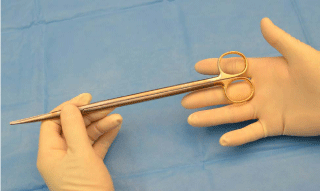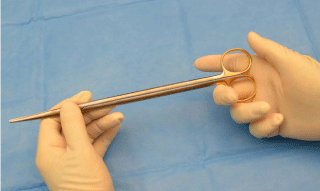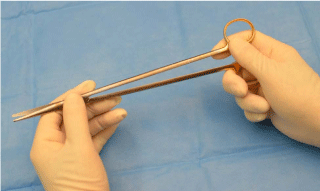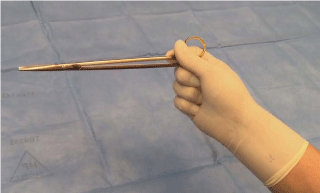Short Communication
A Novel Scissor-Handling Technique for Thoracic Surgery
Takeo S*, Yamazaki K, Takenaka T and Miura N
Division of General Thoracic Surgery, National Hospital Organization Kyushu Medical Center, Japan
*Corresponding author: Sadanori Takeo, Division of General Thoracic Surgery, Respiratory Center and Clinical Institute, National Hospital Organization Kyushu Medical Center, 1-8-1Jigyohama, Chuo-ku, Fukuoka 810-8563, Japan
Published: 29 Sep, 2016
Cite this article as: Takeo S, Yamazaki K, Takenaka T,
Miura N. A Novel Scissor-Handling
Technique for Thoracic Surgery. Clin
Surg. 2016; 1: 1144.
Keywords: Scissor-handling technique; Lung cancer; VATS; Thoracic surgery
Introduction
The use of video-assisted lobectomy combined with a small thoracotomy or complete videoassisted
thoracic surgery (VATS) lobectomy has spread worldwide. Open thoracotomy is also
performed for patients with lung cancer.
The conventional method for handling scissors, such as Mayo scissors, has been described
repeatedly [1]. However, this method was described for use in the formerly more common
conventional open thoracotomy. When working in a small thoracotomy or performing complete
VATS, however, this scissor-handling technique causes the hand and elbow on the holding side to
interrupt the view because of the relatively small and deep working space.
This report describes a new technique for handling scissors when working in a small thoracotomy
or performing complete VATS that does not interrupt the view, while still allowing the surgeon to
perform fine maneuvers.
Surgical Technique
During chest surgery, a curved 10-inch-long Mayo scissors is used in the small working space
created by a small open thoracotomy or ports inside the thoracic cavity.
First, the elbow is slightly bent and the palm of the hand is placed perpendicular to the floor.
Scissors have two blades; one is a moving and cutting blade, while the other is stationary. In this
method, the upper side is the moving blade and the lower side is the stationary blade.
The hand holds the blade side and attaches the ring of the lower
side firmly to the proximal joint of the middle finger (Figure 1). The
middle finger wraps around the lower ring to steady it like the trigger
of a gun, but the finger is not placed into the lower ring (Figure 2).
The ring finger and little finger are slightly bent, and these fingers are
applied to the lower ring (Figure 2).
Next, the blade side of the upper ring is firmly attached between
the index finger and thumb (Figure 3). The index finger is slightly
bent at the second joint, and the side of the first joint of the index
finger is pressed down on the handle of the scissors by the thumb.
Both fingers are not put into the upper ring; this allows the hand
and scissors to form a right angle (Figure 4). The upper ring can
then be moved precisely to separate a blood vessel sheath, perform
exfoliation, or dissect lymph nodes.
Figure 1
Figure 1
The hand holds the blade side and attaches the ring of the lower side firmly to the proximal joint of the middle finger.
Figure 2
Figure 2
The middle finger wraps around the lower ring to steady it like the trigger of a gun, but the finger is not placed into the lower ring.
Figure 3
Figure 4
Figure 4
The index finger is slightly bent at the second joint, and the side of the first joint of the index finger is pressed down on the handle of the scissors by the thumb. Both fingers are not put into the upper ring; this allows the hand and scissors to form a right angle.
Discussion
Conventional Mayo-type scissors can be used to dissect and
divide tissue, spread and open tissue planes, dissect and cut vessels,
assist in tissue palpation, and elevate and bluntly dissect tissue when
closed. When using long Mayo scissors, however, the hand and elbow
on the holding side interrupt the view of a small thoracotomy or
complete VATS because the scissors and hand become straight. If
the long Mayo-type scissors are handled lightly like the right-angled
forceps used for VATS, the point will shake and make fine maneuvers
difficult. When the Mayo-type scissors are exchanged for the rightangled
forceps used for VATS, fine operation is difficult, necessitating
the use of gauze balls, dissectors, and other instruments.
The above-described scissor-handling method causes the scissors
and wrist to form a right angle, and the point of the scissors does
not shake; therefore, all surgical maneuvers that are possible when
using the usual Mayo-type scissors can be performed via this method
in a small thoracotomy and during VATS. The location of the lower
ring changes with the size of the surgeon’s hand; this method is still
appropriate for small hands if the location of the lower ring is changed
from the proximal joint of the middle finger to the palm. The scissorhandling
technique used in any procedure is based on the surgeon’s
preference, but this method is useful for conventional thoracotomy,
small thoracotomy, and sometimes complete VATS lobectomy.
Since 2001, we have applied this method in more than 1,000 cases
of segmentectomy, lobectomy, and pneumonectomy in both open
surgery and VATS. We previously reported this novel procedure for
dissection of the pulmonary artery and veins [2].
Conclusion
A new technique for handling scissors in a small thoracotomy or during complete VATS in patients with lung cancer has been described in this report.




